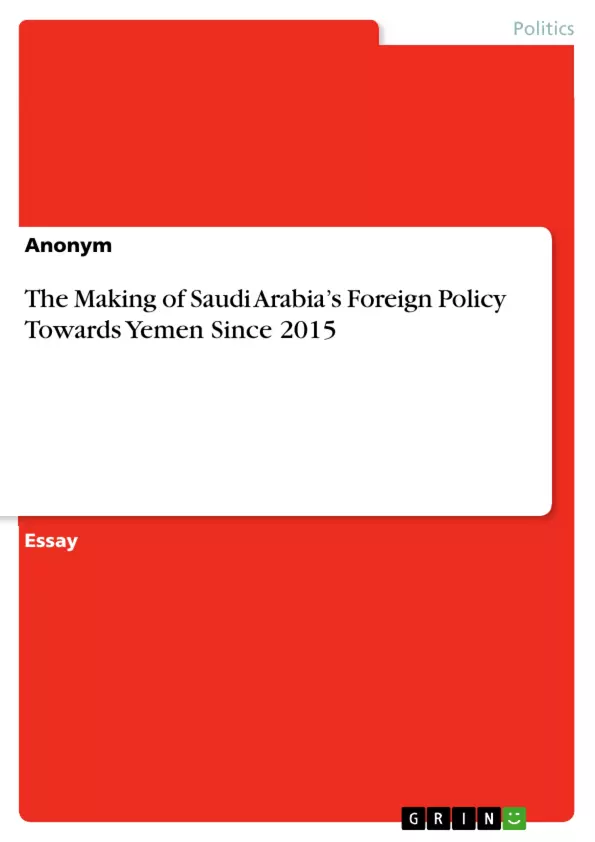When dealing with Saudi Arabia’s policies towards the Yemeni conflict, it is worthwhile taking the domestic level of analysis into consideration. Among the many domestic factors which might be relevant to this study, the author will focus on three dimensions: Saudi Arabia’s population, the economic dimension which also affects the Kingdom’s foreign policy, and the regional environment in the Persian Gulf.
In March 2015, the Kingdom of Saudi Arabia embarked on a military intervention in neighboring Yemen. About half a year earlier, in September 2014, the Shiʿa Houthi rebels (self-declared Ansar Allah, Arabic for “Helpers of God”) had seized control over Yemen’s capital Sanaʿa and forced the incumbent Yemeni president Abdrabbuh Mansur Hadi to flee, first to the Southern city of Aden, then in March 2015 to Saudi Arabia where he has stayed ever since (mostly). The primary goal of the Saudi-led military coalition (including the United Arab Emirates and several Yemeni militias) has been to expel the Houthi rebels from the capital Sanaʿa and to reinstall the internationally recognized government of Abdrabbuh Mansur Hadi (without success until the time of writing).
Which domestic and regional constellations can explain Saudi Arabia’s policies towards Yemen since the beginning of the war in March 2015? Instead of looking at these events from the Realist perspective (i.e. through the lens of the dominant Realism theory in International Relations), a Foreign Policy Analysis (FPA) approach shall be undertaken. While Realism as a school of thought is primarily concerned with (economic and military) power and security, and may thus have certain advantages in the study of authoritarian states in general, and of the Yemen war, the FPA approach offers valuable insights into the making of the Kingdom’s policies towards Yemen. FPA, in contrast to the strict Realist focus on the state as a monolithic category, sheds light on differences within the state and other factors, be they economic or transnational.
Inhaltsverzeichnis (Table of Contents)
- Introduction
- Saudi Arabia's Population
- The Economic Dimension
- Saudi Arabia's Regional Environment
- Conclusion
Zielsetzung und Themenschwerpunkte (Objectives and Key Themes)
This study aims to examine the factors shaping Saudi Arabia's foreign policy towards Yemen since the beginning of the war in 2015. Moving beyond a Realist perspective, the study utilizes a Foreign Policy Analysis (FPA) approach to understand the complexities of the Kingdom's decision-making process.
- The role of domestic factors in shaping Saudi Arabia's Yemen policy
- The influence of Saudi Arabia's population and religious establishment
- The economic dimension and its impact on foreign policy
- The regional environment in the Persian Gulf and its connection to domestic issues
- The interplay between Saudi Arabia's domestic and regional interests in the Yemen conflict
Zusammenfassung der Kapitel (Chapter Summaries)
- Introduction: This chapter introduces the Saudi-led military intervention in Yemen, outlining the conflict's historical context and the objectives of the coalition. It also introduces the FPA approach and its advantages over a Realist framework in understanding Saudi Arabia's foreign policy.
- Saudi Arabia's Population: This chapter explores the internal dynamics within Saudi Arabia, focusing on the relationship between the ruling Sa'ud family and the Wahhabi clergy. It highlights the challenges posed by terrorist organizations and the internal tensions between Sunni and Shi'a populations. The chapter also introduces the hypothesis that Saudi Arabia's Yemen war is framed as an anti-Shi'a and anti-Iranian struggle.
Schlüsselwörter (Keywords)
Key concepts explored in this study include Saudi Arabia's foreign policy, Yemen war, Foreign Policy Analysis (FPA), domestic audience, Saudi population, religious establishment, economic dimension, regional environment, Persian Gulf, Shi'a-Sunni relations, Iran, anti-Shi'a sentiment, anti-Iranian rhetoric, proxy conflict, regional Cold War, and the role of the United States.
- Arbeit zitieren
- Anonym (Autor:in), 2020, The Making of Saudi Arabia’s Foreign Policy Towards Yemen Since 2015, München, GRIN Verlag, https://www.hausarbeiten.de/document/1010845


